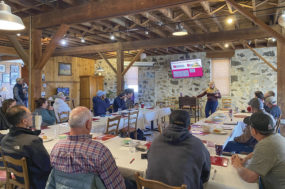You’ve heard Benjamin Franklin’s quote, “… but in this world nothing can be said to be certain, except death and taxes.” But he was only partly right – the other certainty is Idaho wind.
The Bingham County wind is stealing 6 to 12 tons of topsoil per acre per year in some places and has been since at least the year 2000, according to Idaho NRCS state soil scientist Shawn Nield. NRCS staff presented a soil conservation workshop at Wada Farms near Blackfoot in June.
Myth: It takes high winds to create soil erosion. At just 5 mph, sandy soil begins to move. (And in Idaho, we have to ask ourselves, “When was the last time we saw a wind that was less than 5 mph?” … some of us are still looking for our trampolines.)
Wind erosion is classified into three types of soil movement: suspension, saltation and surface creep.
Suspension: Suspension movement is just like it sounds – soil particles suspended for a time into the wind. They churn, they spin and are tossed around, often creating a cloud of particles. These light particles can travel a long way and create “drifts” of dirt when they settle out.
Saltation: Saltation is responsible for 50% to 80% of wind erosion, and instead of being suspended for long periods, they are carried horizontally, increasing their speed. These particles travel further horizontally than vertically, stirring up more particles as they go. When they contact the surface, they do so with force, potentially blowing apart the soil structure.
Surface creep: Surface creep accounts for about 25% of wind erosion. When soil particles are too heavy for the wind to lift, these particles roll across the land surface like tumbleweeds – not just moving but dislodging other particles as well.
Preventives
If farms want to hang onto the soil, there are several preventive measures to curtail erosion. While these methods aren’t new, they remain important enough to revisit frequently, Nield said.
Increase soil aggregation: As sandy soils do not have great stability, one way to increase their chances of stability in wind events is to leave the soil surface rough, as clods are less likely to move in the wind. “Anything bigger than a kernel of wheat will help stop wind erosion,” said Nick Sirovatka, a soil scientist with NRCS Oregon.
Windbreaks, of course, are helpful as well but are not always practical. Other ways to mitigate wind damage might include:
- Farming in strips or terracing (where practical) to make sure all the ground isn’t bare at the same time
- Staggering timing for removing cover
- Leaving living roots
- Changing residue management
- Changing crop rotations
- During high spring winds, moistening dry soil to make it heavier and thus less moveable
- Increasing vegetation
Sirovatka referred to the 2010 University of Nebraska – Lincoln soil study which found that increasing soil cover just 20% reduced relative soil loss by 60%, regardless of residue type. This makes a strong case for leaving crop residue during winter and as late as possible during springtime winds. The study also noted that standing residues are more effective than the same quantity of residue lying flat on the surface.
If we can keep wind erosion under control, maybe then we’d only have to worry about planning for death and taxes, and finding where our trampolines are nesting.







